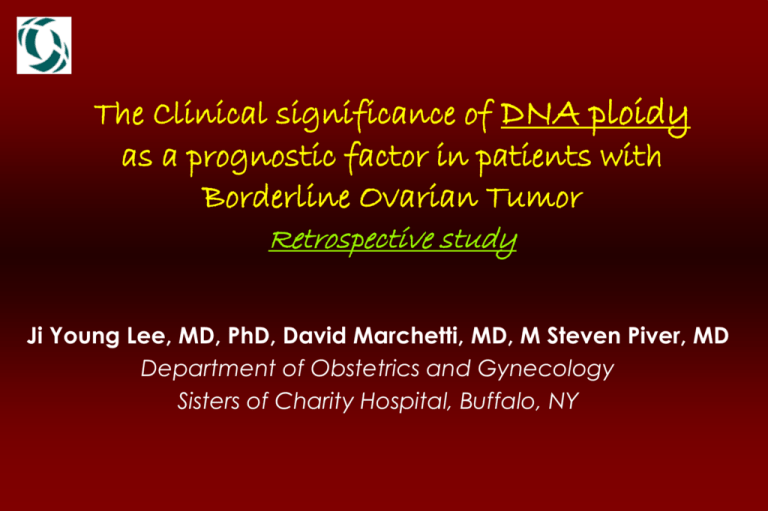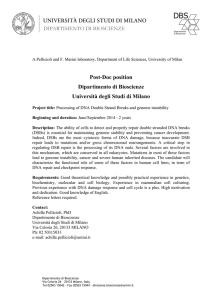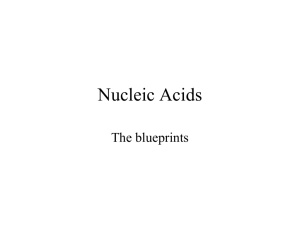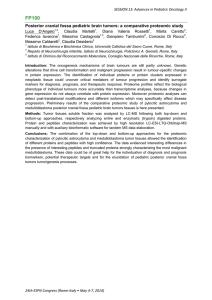The Clinical significance of DNA ploidy as a prognostic factor in
advertisement

The Clinical significance of DNA ploidy as a prognostic factor in patients with Borderline Ovarian Tumor Retrospective study Ji Young Lee, MD, PhD, David Marchetti, MD, M Steven Piver, MD Department of Obstetrics and Gynecology Sisters of Charity Hospital, Buffalo, NY INTRODUCTION Howard Taylor Described Borderline Ovarian Tumor as “semi-malignant” ….propensity to metastasize but maintained a rather indolent course… Surg Gynecol Obstet 1929; 48: 204-230 10-20% of epithelial ovarian tumor Mean age 45.7 yr 75% of tumors are Stage I 5 YSR for early stage tumors ≥ 95% Recurrence rate 8~32% Risk factors for recurrence FIGO stage, Age, Residual disease, Histology, DNA ploidy etc. DNA Ploidy The most important prognostic factor in 370 patients with the borderline ovarian tumor Int J Gynecol Oncol 1993 3: 349 A Review of the Literature OBJECTIVES 1. Report the results regarding DNA ploidy and other Clinicopathologic variables 2. Evaluate the clinical significance of DNA Ploidy in 30 consecutive patients with Borderline Ovarian Tumor MATERIALS & METHODS Retrospective Study Review of Cancer Registry of Sisters Hospital A total of 30 consecutive patients with Borderline Ovarian Tumor Histologic evaluation of Paraffin Tissue Blocks DNA Flow Cytometry for DNA ploidy Analysis -Primary Tumor Histology Definition Malignant characteristics of epithelial hyperplasia or stratification, mitotic activity, and cellular/nuclear atypia No Stromal Invasion MUCINOUS TYPE DNA Flow Cytometry by USLABS (Irvine, CA) Diploid ( DI=1.0, single peak) Aneuploid (DI;1.1-1.9), Multi-peak RESULTS ….and DISCUSSION Patients (No.) Age Distribution of Borderline Ovarian Tumor 8 MEAN AGE 54.5 yo 7 6 5 4 3 2 1 0 20-29 30-39 40-49 50-59 60-69 70-79 80-89 Age Age distribution of Borderline Ovarian Tumor Sep 1993 – Sep 2004 in Sweden Int J Gynecol Cancer 2008;18:453–459. Patients (No.) Histology and Age Distribution of Borderline Ovarian Tumor 5 4 Serous 3 Mucinous 2 Mixed 1 0 20-29 30-39 40-49 50-59 60-69 70-79 80-89 Age Patients (No.) DNA Ploidy and Age at Diagnosis 6 Diploid 5 4 Aneuploid 3 2 1 0 20-29 30-39 40-49 50-59 60-69 70-79 80-89 Age The relationship of Histopathology and FIGO stage of disease Serous Mucinous Mixed Total IA 8(50%) 4(50%) 2 14 IB 1(8%) 1 1 3 Stage (%) IC 4(21%) 0 0 4 Total II 0 1 1 2 III 3(21%) 1 0 4 NA 0 1 2 3 16 8 6 30 The relationship of DNA ploidy and Histology of disease DNA ploid Aneuploidy Diploidy Histology Serous Mucinous Mixed 4 (45%) 2 (22%) 3 (33%) 12 (58%) 6 (28%) 3 (14%) Total 9 (100%) 21 (100%) Patients (No.) DNA ploidy and Histologic type 14 12 58% 10 8 28% 6 14% 4 2 0 Serous-Diploid Serous-Aneuploid Mucinous-Diploid MucinousAneuploid Mixed-Diploid Mixed-Aneuploid Histology-DNA Ploidy The relationship of DNA ploidy and FIGO stage of disease DNA ploid Aneuploidy Diploidy FIGO Stage IA IB IC II III Unstaged Total 2 1 2 1 2 1 9 (30%) 12 2 2 1 2 2 21 (70%) pl oi d lo id -D ip -A ne up lo Un id sta ge dDi Un pl sta oi d ge dAn eu pl oi d III III lo id IIAn eu p IIDi IC -A ne up lo id lo id -D ip IC IB -A ne up lo id lo id IB -D ip lo id IA -A ne up IA -D ip lo id Patients (No.) DNA Ploidy and Disease Stage 14 12 Diploid 10 8 Aneuploid 6 4 2 0 Stage-DNA Ploidy Characteristics of 30 patients Characteristics Age < 50 ≥ 50 Ethnicity Caucasian African-American FIGO Stage IA IB IC II-III Unstaged Pelvic Cytology positive Negative Histology Serous Mucinous Mixed Chemotherapy Yes No TOTAL (n=30) Diploid (n=21) Aneuploid (n=9) p value 11 19 5 16 6 3 0.09 29 1 21 8 1 0.002 14 3 4 6 3 12 2 2 3 2 2 1 2 3 1 0.007 6 24 4 17 2 7 0.1 16 8 6 12 6 3 4 2 3 0.4 4 26 3 18 1 8 Histology Borderline Ovarian Tumor Tropé CG. Seminars in surgical oncology 2000 9(1)69 –75 The relation of histopathology to ploidy status Histopathology Serous Mucinous Endometrioid Clear cell Mixed Total Number of cases (%) 219 (54.9) 171 (42.9) 5 (1.2) 1 (0.2) 3 (0.8) 399 Diploid Aneuploid No FCM 167 127 3 — 2 27 32 2 1 1 25 12 — — — 299 63 37 Int J Gynecol Cancer 2008;18:453–459. Overall Recurrence and survival in Borderline ovarian tumor Stage I Stage II & III Total N 686 219 905 Recurred 29 40 69(7.6%) Died 9 22 31(3.4%) Rubin SC, Sutton GP (2001,Ovarian cancer 2nd edition) DNA Ploidy and Prognosis in Borderline Ovarian Tumor (I) Cancer 1992 69(10): 2510 DNA Ploidy and Prognosis in Borderline Ovarian Tumor (II) Seidman JD et al. Cancer 1993;71:12 …DNA ploidy may be of little prognostic importance Harlow BL et al. Gynecol Oncol 1993;50:305 …No correlation between DNA ploidy and Survival or Recurrence Mean Follow-up 36 months ( range 6-72 months ) No recurrence in 30 patients No death from disease Chemotherapy was given to 4 of 30 patients (1 stage IIC-Aneuploidy and 3 IIIC stage-Diploidy) CONCLUSION DNA was not recognized as an important prognostic factor in this study More prolonged follow-up will be needed to evaluate the clinical correlation between DNA ploidy and recurrence / survival Reassess the quality and quantity of tissue blocks for DNA Ploidy analysis REFERENCES 1. Ta ylor HC. Mali gnant and semim ali gnant tu mors of the ovary. Surg Gynecol Obstet 1929;48:204 -30. 2. Zanetta G, Rota S, Chiari S, Bonazzi C, Bratina G, and Mangioni C. Behavior of borderli ne tumors with particular interest to persisitence, recurre nce, and progression to invasive carcinoma: Prospective study. J Cli n Oncol 2001;19:2658 -64. 3. McKenney J, Balzer BL, Longacre TA. Patte rnsof stromal invasion in ovarian serous tumors of low mali gnant potential (borderli ne tumors): A reevaluation of the concept of stromal mi croinvasion. Am J Surg Pathol 2006;30:1209-21. 4. Kurman RI, Trim ble CL. The behavior of serous tumors of low mali gnant potential; Are they ever mali gnant? Int J Gynecol Pathol 1993;12:120 -7. 5. Creasman WT, Park R, Norris H, et al. Stage I : B orderli ne oarian tumors. Obstet Gynecol 1982;59:93 -6. 6. Sil va EG, Gershenson DM, Malpica A, Deavers M. The recurrence and the overall survival rates of ovarian serous borderline neoplasms with n oninvasive im plants is time dependent. Am J Surg Pathol 2006;30:136 7-71. 7. Dresc her CW, Fli nt A, Hpkins MP, Roberts JA. Prognostic signifi cance of DNA content and nuclear morphology in borderline ovarian tumors. Gynecol Oncol 1993;48:242 -6. 8. Chambers JT, Merino MJ, Kohorn EL, Schwartz PE. Borderli ne ovarian tumors. Am J Obstet Gynecol 1988;159:1088 -94. 9. Bostwick DG, Taze laar HD, Ball on SC, Hendrickson MR, Kempson RL. Ovarian epitheli al tumors of b orderli ne mali gnancy. A cli nical and pathologic study of 109 cases. Cancer 1986;58:2052 -65. 10. Lai CH, Hsue h S, Chang CJ, Tse ng CJ, Hua ng KG, Chou HH, et al. The role of DNA fl ow cytomery in borderli ne mali gnant ovarian tumors. Cancer 1996;78:79 4-802. 11. Friedlander ML, Russe ll P, Taylor IW, Hedley DW, Tattersall MHN. Flow cytometric analy sis of cell ular DNA content as an adjunct to the diagnosis of ovarian tumors of borderli ne mali gnancy. Pathology 1984;16:301 -6. 12. Fu YS, Ro J, Reaga n JW, Hall TL, Berek J. Nuclear deoxyribonucleic acid heterogeneity of ovarian borderli ne mali gnant serous tumors. Obstet Gynecol 1986;67: 478-82. 13. Dietel M, Arps H, Rohlff A, Bodecker R, Niendorf A. Nuclear DNA content o f borderli ne tumors of the ovary: correlation with hi stology and signifi cance for prognosis. Virchows Arch A Pathol An at Histopathol 1986;409: 829 -36. 14. Kaern J, Trope CG, Kristensen GB, Abeler VM, Pettersen EO. DNA ploidy the most im portant prognostic factor in patients with borderli ne tumors of the ovary. Int J Gynecol Cancer 1993;3:349 -58. 15. Padberg BC, Arps H, Franke U, Thiedemann C, Rephenning W, Stegner HE, et al. DNA cytophoto metry and prognosis in ovarian tumors of borderli ne mali gnancy. Cancer 1992;69:2510 -4. 16. Seidman JD, Norris HJ, Griffi n JL, Hitchcock CL. DNA fl ow cytometric analy sis of serous ovarian tumors of low mali gnant potential. Cancer 1993;71:3947 -51. 17. Demi rel D, Laucirica R, Fishman A, Owens RG, Grey MM, Kaplan AL, et al. Ovarian tumors of low mali gnant potential. Correlation of DNA index and S-phase fraction with histopathologic grade and cli nical outcome. Cancer 1996;77:1494 -500. 18. de Nictoli s M, Montironi R, Tomm asoni S, Carinelli S, Ojeda B, Matias-Guiu X, et al. Serous borderli ne tumors of the ovary. A cli nicopathologic, imm unohistochemi cal, and quantitative study of 44 cases. Cancer 1992;70:152 -60. 19. Harlow BL, Fuhr JE, McDonald TW, Schwartz SM, Beuer lein FJ, Weiss NS. Flow cytometry as a prognostic indicator in women with borderli ne epitheli al ovarian tumors. Gynecol Oncol 1993;50:305 -9. 20. Ingelm an-Sundberg A. Classifi cation and stagin g of mali gnant tumors in the female pelvis. Acta Obstet Gynecol Scand 1971;50:1-7. 21. Hedley DW, Freidlander ML, Taylor IW, et al. Method for analy sis of cell ular DNA content o f paraffi n-embedded pathological material using fl ow cytometry. J Histochem Cytochem 1983;31:1333. 22. Heintz AP, Odicino F, Maisonneuve P, Bell er U, Benedet JL, Creasman WT, et al. Carcinoma of the ovary. Int G Gynecol Obstet 2003;83:135 -66. 23. Sherman ME, Mink PJ, Curtis R, Cote TR, Brooks S, Hartge P, et al. Survival among women with b orderli ne ovarian tumors and ovarian carcinoma: a population-based analy sis. Cancer 2004;100:1045 -54. 24. Trim ble CL, Kosary C, Tr im ble EL. Long-term survival and patte rns of care in women with ovarian tumors of l ow mali gnant pote ntial. Gynecol Oncol 2002;86:34 -7. 25. Kaern J, Trope C, Kjorstad KE, beler V, Pettersen EO. Cell ular DNA content as a new prognostic too l in patients with borderli ne tumors of the ovary. Gynecol Oncol 1990; ACKNOWLEDGEMENT M Steven Piver, MD David Marchetti, MD Judine Davis, MD Anthony Pivarunas, DO Pathology Department USLABS, CA


